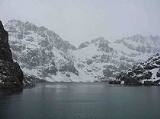
Larsen Harbour
Encyclopedia

Drygalski Fjord
Drygalski Fjord is a bay 1 mile wide which recedes northwest 7 miles , entered immediately north of Nattriss Head along the southeast coast of South Georgia.According to L...
, entered 2.5 miles (4 km) west-northwest of Nattriss Head
Nattriss Head
Nattriss Head is a small but prominent rock headland marking the south side of the entrance to Drygalski Fjord on the southeast coast of South Georgia. Charted by German Antarctic Expedition, 1911-12, under Filchner. It was named Nattriss Point for E.A. Nattriss, shipping officer to the Discovery...
, at the southeast end of South Georgia. It was charted by the German Antarctic Expedition, 1911-12, under Filchner
Wilhelm Filchner
Wilhelm Filchner was a German explorer.At the age of 21, he participated in his first expedition, which led him to Russia. Two years later, he travelled alone and on horseback through the Pamir Mountains, from Osh to Murgabh to the upper Wakhan to Tashkurgan and back...
, who named it for Captain Carl Anton Larsen
Carl Anton Larsen
Carl Anton Larsen was a Norwegian Antarctic Explorer, who made important contributions to the exploration of Antarctica, the most significant being the first discovery of fossils, for which he received the Back Grant from the Royal Geographical Society...
a Norwegian
Norway
Norway , officially the Kingdom of Norway, is a Nordic unitary constitutional monarchy whose territory comprises the western portion of the Scandinavian Peninsula, Jan Mayen, and the Arctic archipelago of Svalbard and Bouvet Island. Norway has a total area of and a population of about 4.9 million...
Antarctic
Antarctic
The Antarctic is the region around the Earth's South Pole, opposite the Arctic region around the North Pole. The Antarctic comprises the continent of Antarctica and the ice shelves, waters and island territories in the Southern Ocean situated south of the Antarctic Convergence...
Explorer, who made significant contributions to the exploration of Antarctica. The most significant being the first discovery of fossils, for which he received the Back Grant from the Royal Geographical Society
Royal Geographical Society
The Royal Geographical Society is a British learned society founded in 1830 for the advancement of geographical sciences...
. Larsen is also considered the founder of the Antarctic whaling
Whaling
Whaling is the hunting of whales mainly for meat and oil. Its earliest forms date to at least 3000 BC. Various coastal communities have long histories of sustenance whaling and harvesting beached whales...
industry and the settlement at Grytviken
Grytviken
Grytviken is the principal settlement in the British territory of South Georgia in the South Atlantic. It was so named in 1902 by the Swedish surveyor Johan Gunnar Andersson who found old English try pots used to render seal oil at the site. It is the best harbour on the island, consisting of a...
, South Georgia.
The peaks and mountain crests surrounding the almost land-locked harbour was described by Sir Ernest Shackleton's
Ernest Shackleton
Sir Ernest Henry Shackleton, CVO, OBE was a notable explorer from County Kildare, Ireland, who was one of the principal figures of the period known as the Heroic Age of Antarctic Exploration...
photographer Frank Hurley as "most beautiful and exceeding all in grandeur even that of Milford Sound
Milford Sound
Milford Sound is a fjord in the south west of New Zealand's South Island, within Fiordland National Park, Piopiotahi Marine Reserve, and the Te Wahipounamu World Heritage site...
".
The Niall Rankin expedition aboard the Albatross, spent some time here as they studied the Weddel seal
Weddell Seal
The Weddell seal , is a relatively large and abundant true seal with a circumpolar distribution surrounding Antarctica. Weddell seals have the most southerly distribution of any mammal, with a habitat that extends as far south as McMurdo Sound...
colony before going on to Esbensen Bay
Esbensen Bay
Esbensen Bay is a small bay one nautical mile southwest of Nattriss Head, along the southeast end of South Georgia. Charted by the German Antarctic Expedition, 1911–12, under Filchner, it is named for Captain Wictor Esbensen, manager of the Compañía Argentina de Pesca whaling station at Grytviken,...
.
The area is rat-free, allowing species such as the South Georgia Pipit
South Georgia Pipit
The South Georgia Pipit is a sparrow sized bird, only found on the South Georgia archipelago. It is the Antarctic's only song bird, and South Georgia's only passerine, and one of the few non-seabirds of the region....
, and burrowing petrel
Petrel
Petrels are tube-nosed seabirds in the bird order Procellariiformes. The common name does not indicate relationship beyond that point, as "petrels" occur in three of the four families within that group...
s and prion
Prion
A prion is an infectious agent composed of protein in a misfolded form. This is in contrast to all other known infectious agents which must contain nucleic acids . The word prion, coined in 1982 by Stanley B. Prusiner, is a portmanteau derived from the words protein and infection...
s to thrive. Mountains descend steeply into the sea here, and various glaciers calve
Ice calving
Ice calving, also known as glacier calving or iceberg calving, is a form of ice ablation or ice disruption. It is the sudden release and breaking away of a mass of ice from a glacier, iceberg, ice front, ice shelf, or crevasse...
into the sea.

